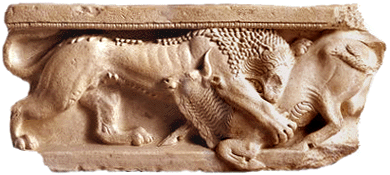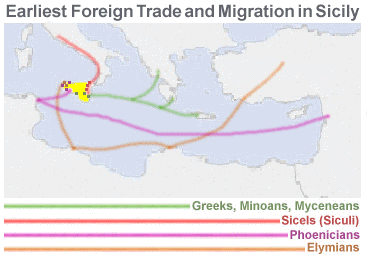...Best of Sicily presents... Best of Sicily Magazine. ... Dedicated to Sicilian art, culture, history, people, places and all things Sicilian. |
by Vincenzo Salerno | |||||
Magazine Index Best of Sicily Arts & Culture Fashion Food & Wine History & Society About Us Travel Faqs Contact Map of Sicily
|
Generally, the Sicels occupied a region extending from Cape Peloro, north
of Messina, into the Peloritan and Nebrodi There are theories that the Sicels came from Liguria or Latium, and some scholars have also suggested an affinity with the Lucanian culture. A close link with the Etruscans (themselves early arrivals from beyond Italy) seems less likely. The Sicels' distinctive religious cults, characterised by worship of the Palikoi and other deities, co-existed well with veneration of the Hellenic gods. The Greek writer Thucydides attributes an Italic origin to the Sicels, and evidence supports this, but the accuracy of the quasi-historical musings of certain Greek writers (particularly Diodoros Siculos) has been called into question for a long time. Identifying typically "Sicel" gene markers has, for the moment, proven challenging. In considering the earliest Sicilian societies, the very term "indigenous" is rather subjective because "modern" humans actually migrated to the Mediterranean region, albeit tens of millennia ago. (Nobody has "always" been here; in terms of remote human ancestry, we're all "African.") The Sikelian language shared at least some characteristics with the languages that evolved into Latin; Siculan was probably an Italic tongue. Unlike Sicanian, Siculan was clearly Indo-European. It is generally accepted that the Sicels were related to various Italic peoples, such as the Italoi and Opicans, who were eventually assimilated by Oscan-speaking peoples, and this explains a degree of cultural affinity with the Italoi (of nearby Calabria). It is believed that Siculan was not written until the Greeks introduced their alphabet in Sicily. The Siculan "Inscription of Sciri" (near Caltagirone) consists of characters similar to Roman ones, though with some Greek elements. The verb "to be" in Sicel appears to have been esti --similar to Greek and to the Latin est. So far as we know, the most important Sicel towns were Agyrium, Centuripae, Henna and three towns called Hybla, all still inhabited today. Their society was a loose federation which one of their last great leaders, the Hellenised Ducetius (Docetios), tried to restore and then liberate from Greek influence in a series of revolts in the 440s BC. In the end, the Greek Syracusans defeated the Sicels and destroyed their shrine at Palické. Even Ducetius' name seems Latin (akin to the Latin dux meaning "leader"), but his education was Greek and he spent time at Corinth. When it was convenient, he played Greek against Greek, an effective strategy because Sicily's Greek cities were, in effect, independent states. In 446 BC, following a series of military defeats, Ducetius founded the Siculo-Greek city of Cale Acte, on the northern coast in what is now the province of Messina. He died around 440. Genetic Research: In general, studies of population genetics in Sicily tend to confirm, rather than refute, what we already presume to know about the various Sicilian peoples based on available historical, archeological and ethnological information. Here is a brief summary of an early genetic study involving potential identification of Sicily's three "native" peoples correlative to genetic factors in the current population: Autosomal Microsatellite and mtDNA Genetic Analysis in Sicily DNA samples from 465 blood donors living
in seven (7) towns of Sicily have been collected according
to well defined criteria, and their genetic heterogeneity A more reliable association of these diachronic genetic strata to different historical populations (e.g. Sicani, Elymians, Sicels), if possible, must be postponed to the analysis of more samples and hopefully more informative uniparental DNA markers such as the recently available DHPLC-SNP polymorphisms of the Y chromosome. V. Romano, F. Calì, A. Ragalmuto, R. P. D'Anna, A. Flugy, G. De Leo, O. Giambalvo, A. Lisa, O. Fiorani, C. Di Gaetano, A. Salerno, R. Tamouza, D. Charron, G. Zei, G. Matullo and A. Piazza - - - Annals of Human Genetics, January 2003 (Volume 67, Number 1, Page 42). About the Author: Palermo native Vincenzo Salerno has written biographies of several famous Sicilians, including Frederick II and Giuseppe di Lampedusa. | ||||
Top of Page |
 The Sicels (or Sikels, from the Greek Sikeloi),
though considered one of the three "indigenous" societies of Sicily
(with the
The Sicels (or Sikels, from the Greek Sikeloi),
though considered one of the three "indigenous" societies of Sicily
(with the  mountains, southwest toward Henna (Enna)
and southward beyond Etna, to include a strip of coastal and inland areas
toward Sicily's southeastern tip. They had extensive --usually peaceful--
contact with the Sicanians (Sicily's earliest race), who their settlements
gradually displaced toward the west. Coincidentally, the Sicels were present
in the first part of Sicily colonised by Greeks, whose initial, exploratory
incursions began as early as 800 BC.
mountains, southwest toward Henna (Enna)
and southward beyond Etna, to include a strip of coastal and inland areas
toward Sicily's southeastern tip. They had extensive --usually peaceful--
contact with the Sicanians (Sicily's earliest race), who their settlements
gradually displaced toward the west. Coincidentally, the Sicels were present
in the first part of Sicily colonised by Greeks, whose initial, exploratory
incursions began as early as 800 BC. tested on the
basis of 9 autosomal microsatellite and mitochondrial DNA polymorphisms
for a total of 85 microsatellite allele and 10 mtDNA haplogroup frequencies.
A preliminary account of the results shows that: a) the samples are genetically
heterogeneous; b) the first principal coordinates of the samples are correlated
more with their longitude than with their latitude, and this result is even
more remarkable when one outlier sample (Butera) is not considered; c) distances
among samples calculated from allele and haplogroup frequencies and from
the isonymy matrix are weakly correlated (r = 0.43, P = 0.06) but such correlation
disappears (r = 0.16) if the mtDNA haplogroups alone are taken into account;
d) mtDNA haplogroups and microsatellite distances suggest settlements of
people occurred at different times: divergence times inferred from microsatellite
data seem to describe a genetic composition of the town of Sciacca mainly
derived from settlements after the Roman conquest of Sicily (First Punic
War, 246 BC), while all other divergence times take root from the second
to the first millennium BC, and therefore seem to backdate to the pre-Hellenistic
period.
tested on the
basis of 9 autosomal microsatellite and mitochondrial DNA polymorphisms
for a total of 85 microsatellite allele and 10 mtDNA haplogroup frequencies.
A preliminary account of the results shows that: a) the samples are genetically
heterogeneous; b) the first principal coordinates of the samples are correlated
more with their longitude than with their latitude, and this result is even
more remarkable when one outlier sample (Butera) is not considered; c) distances
among samples calculated from allele and haplogroup frequencies and from
the isonymy matrix are weakly correlated (r = 0.43, P = 0.06) but such correlation
disappears (r = 0.16) if the mtDNA haplogroups alone are taken into account;
d) mtDNA haplogroups and microsatellite distances suggest settlements of
people occurred at different times: divergence times inferred from microsatellite
data seem to describe a genetic composition of the town of Sciacca mainly
derived from settlements after the Roman conquest of Sicily (First Punic
War, 246 BC), while all other divergence times take root from the second
to the first millennium BC, and therefore seem to backdate to the pre-Hellenistic
period.